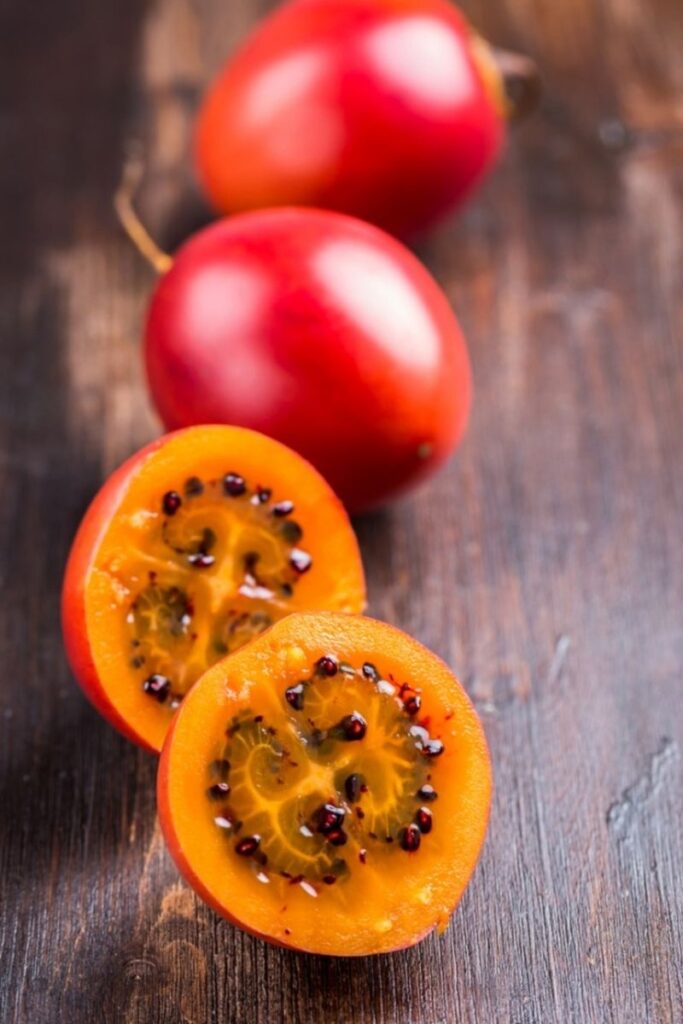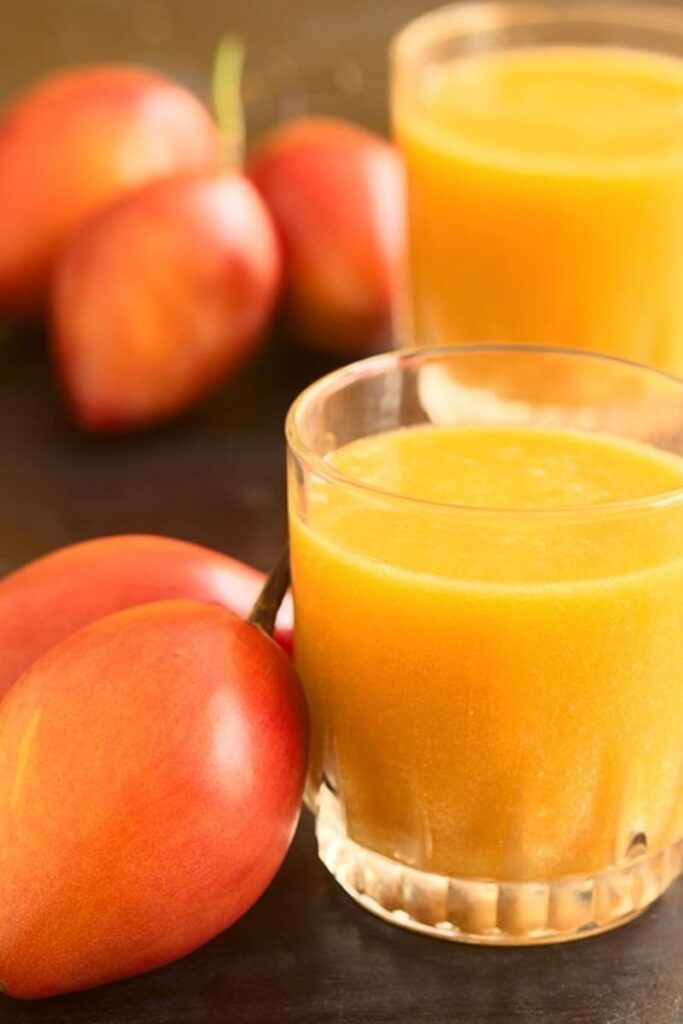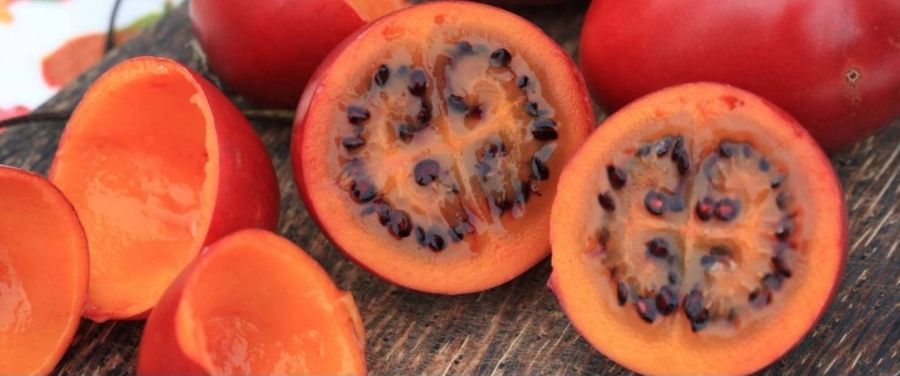What Is Tamarillo Fruit?
Tamarillo is an egg-shaped edible fruit. Other names include tree tomatoes, ibinyomoro, tomate de árbol, tomate serrano, blood fruit, tomate andino, tomate de yuca, sachatomate, berenjena, tomate de españa and tamamoro. The scientific name of tamarillo is Solanum betaceum. It belongs to the family Solanaceae. Tamarillo fruits are low in calories and contain a rich amount of iron and vitamins. These fruits are loved by people of all age groups.
The tamarillo fruit is native to Andes of Ecuador, Peru, Colombia, Chile, Argentina, and Bolivia. Other regions of cultivation are Kenya, South Africa, Rwanda, Nagaland, Sikkim, and Darjeeling in India, Hong Kong, China, Nepal, Australia, the United States, and New Zealand.
Description
The plant grows up to 5 meters and the plant life expectancy is about 12 years. The leaves of the plant are simple, large, perennial, and have a strong pungent smell. The flowers of tamarillo are pink—white and form groups of 10 to 50 flowers.
READ: Rambutan Fruit Nutrition, Health Benefits and Side Effects
The fruits are about 4 to 10 cm long. Their color varies from yellow and orange to red and almost purple.
Nutritional Value Of Tamarillo
Per 100-gram serving of tamarillo fruit contains —
- Calories: 31
- Total Fat: 0.36 grams
- Carbohydrates: 3.8 grams
- Proteins: 2 grams
- Dietary Fiber: 3.3 grams
- Folate: 4 micrograms
- Niacin: 0.271 milligrams
- Vitamin A: 189.17 micrograms
- Vitamin C: 29.8 milligrams
- Vitamin E: 2.09 milligrams
- Sodium: 1.44 milligrams
- Potassium: 321 milligrams
- Calcium: 10.7 milligrams
- Magnesium: 20.6 milligrams
- Manganese: 114 micrograms
- Phosphorus: 38.9 milligrams
- Pyridoxine: 0.198 milligrams
- Thiamine: 0.043 milligrams
- Copper: 0.051 milligrams
- Iron: 0.57 milligrams
- Selenium: 0.1 micrograms
- Zinc: 0.15 milligrams
Health Benefits Of Tamarillo (Tree Tomato)
Tree tomato (tamarillo) contains antioxidant, anti-inflammatory, anti-viral, anti-fungal, anti-bacterial and hypoglycemic properties. Its health benefits include —

1. Nutrition-Dense
Tamarillo fruit comes with many essential vitamins, minerals, and healthful antioxidants. It is rich in vitamins A, vitamin C, and vitamin E. It also contains B-complex vitamins such as thiamine, riboflavin, and niacin.
In addition, this small fruit is also a good source of calcium, potassium, carbohydrates, protein, magnesium, phosphorus, sodium, copper, zinc, and iron.
2. Promotes Weight Loss
If you’re looking for losing weight, then this fruit is really for you GUYS!
Along with very low-calorie content, tamarillo contains a high amount of fiber. In addition, it has high water content. High fiber and water contents present in this small fruit keep you full for longer, reduce the need to have snacks constantly and you eat less.
READ: 17 Research-Based Benefits of Kiwi Fruit
Tamarillo fruit also has some acidic properties which help to cut—down fat. You can consume it raw, in salads, or in juice form. It also acts as a natural detoxifier that works to flush out toxins from the body.
3. For Skin
The benefits of tamarillo fruit can also be seen here. As we have previously described in the article, this fruit contains vitamin A, vitamin C, and vitamin E in plenty. All these nutrients help your skin look healthy and radiant.
Flavonoids, phenols, and anthocyanins present in tree tomatoes work to protect your skin from pollution and oxidative stress that can cause blemishes, acne, wrinkles, and pimples. Tamarillo also acts as an anti-aging agent. In addition, it can also be used as home remedies for various skin problems.
4. Helps Control Diabetes
Tamarillo contains chlorogenic acid, which helps to lower the levels of blood sugar in type-2 diabetes mellitus.
READ: Sapodilla or Chikoo Fruit: Nutrition and Amazing Health Benefits
Due to its high antioxidant properties, tamarillo may reduce oxidative stress in human organs. Consuming its pulp or tamarillo juice on a light stomach would provide better health advantages.
5. Support Heart Health
As previously discussed, tree tomato comes with protein, soluble fiber, starch, anthocyanins, and carotenoids. All these nutrients help to reduce the risk of cardiovascular diseases. High sodium levels in the body are the leading cause of many heart diseases.
Tree tomatoes contain higher amounts of potassium which help to balance sodium levels in the body. In addition, it is rich in magnesium which works to regulate the proper functioning of your cardiovascular system. Also, the fiber content found in this fruit plays a vital role in treating bad cholesterol or LDL cholesterol.
In addition to this, its excellent antioxidant properties help to reduce oxidative stress that may lead to stroke.
6. Reduce Blood Pressure
The health benefits of tree tomatoes (tamarillo) can be seen here. Tree tomatoes are a good source of minerals and potassium which may help to reduce high blood pressure (hypertension).
READ: 12 Health Benefits of Avocado Fruit
In addition, carotenoids present in the fruit work to aid in lowering the risk of coronary heart diseases, that are linked to hypertension. Thus, including this small fruit in your daily diet can help you to get rid of systolic blood pressure.
7. Boost Metabolism
A diet enriched with minerals and vitamins is vital in supporting the proper functioning of the body. And proper functioning of the body may lead to good metabolic activities. Tamarillo contains vitamin B6 in plenty which helps to aid in the production of energy.
It helps to convert calories into useful energy, thereby limiting excessive weight gain as well. The vitamin also works to contribute towards improving the metabolism, easing the transportation of blood. It is also effective in combating obesity.

8. Fights Cancer
Tree tomatoes (tamarillo) are rich in antioxidant properties, which help in fighting the free radicals that cause cancer. A healthy compound called, anthocyanin found in the fruit help to protect your body against oxidative damage.
READ: Banana Fruit: 14 Best Health Benefits of Bananas
A variety of antioxidants such as polyphenols, flavonoids, and chlorogenic compounds in tree tomatoes may work to prevent the onset of cancer, especially breast and colon cancer. The anti-inflammatory properties also contribute to this function. In addition, the anti-inflammatory and anti-microbial properties of the fruit stave off cancerous outbreaks.
9. Improves Eyesight
The benefits of tamarillo fruit can also be seen for better eye health. Due to its higher contents of carotenoids and vitamin A, tamarillo may aid in bettering your vision. Consuming tamarillo fruit in moderate quantity may help to delay the development of age-related vision problems including cataracts and macular degeneration.
In addition, another compound called, beta-carotene present in it is also linked with improved eye health.
10. For Hair
The benefits of tamarillo do not end here. Whole tamarillo has been widely used in cosmetic health. Not only for the skin, but this fruit is extremely beneficial in improving the health of your hair and nails.
READ: Pineapple Fruit Nutrition, Health Benefits and Side-Effects
The polyunsaturated linoleic acid found in it is really very effective in treating psoriasis, eczema, dandruff, and hair loss. Its essential fatty acid content helps to strengthen your hair from root to tip.
11. Boosts Immunity
Tree tomatoes contain high amounts of vitamin C, which can play an important role in treating various health ailments. It also helps to keep you away from colds and infections. However, it is vital to consume this fruit in a moderate quantity.
12. Fights Anemia
Due to its higher iron contents, this fruit can help to treat anemia to some extent. It works to promote and regulate the production of red blood cells (RBCs), which triggers the production of blood in the body. It also helps to overcome the symptoms associated with it such as weakness, fatigue, and dizziness.
13. Treat Inflamed Tonsils
Although tree tomato (tamarillo) has a wide range of benefits, its impact on treating inflammation caused in the lymph nodes has been studied extensively. Therefore, it is considered to be one of the best benefits offered by this small fruit. Its anti-inflammatory properties help to reduce the size of swelling in the tonsils by destroying the bacteria that cause the infection.
Take Away
A tree tomato or tamarillo fruit can do wonders for your overall health. Hence, incorporate it into your daily diet to keep health problems at bay.
REFERENCES:
- Liefting, L. W., Ward, L. I., Shiller, J. B., & Clover, G. R. G. (2008). A new ‘Candidatus Liberibacter’species in Solanum betaceum (tamarillo) and Physalis peruviana (cape gooseberry) in New Zealand. Plant Disease, 92(11), 1588-1588.
- Guimarães, M. L., Tomé, M. C., & Cruz, G. S. (1996). Cyphomandra betacea (Cav.) Sendtn.(Tamarillo). In Trees IV(pp. 120-137). Springer, Berlin, Heidelberg.
- Prohens, J., & Nuez, F. (2001). The Tamarillo (Cyphomandra betacea) A Review of a Promising Small Fruit Crop. Small Fruits Review, 1(2), 43-68.
- Lister, C. E., Morrison, S. C., Kerkhofs, N. S., & Wright, K. M. (2005). The nutritional composition and health benefits of New Zealand tamarillos. Crop & Food Research Confidential Report, (1281), 29.
- Ramírez, F., & Kallarackal, J. (2019). Tree tomato (Solanum betaceum Cav.) reproductive physiology: A review. Scientia Horticulturae, 248, 206-215.
- Skinner, S. J., Hunter, D., Cho, S., & Skinner, M. (2013). The potential health benefits of the subtropical fruits kiwifruit, feijoa and tamarillo. Bioactives in Fruit: Health Benefits and Functional Foods, 169-195.
- Kadir, A., Aizan, N. A., Rahmat, A., & Jaafar, H. Z. (2015). Protective effects of tamarillo (Cyphomandra betacea) extract against high fat diet induced obesity in Sprague-Dawley rats. Journal of obesity, 2015.
- Maria, A. G., Graziano, R., & Nicolantonio, D. O. (2015). Carotenoids: potential allies of cardiovascular health?. Food & nutrition research, 59(1), 26762.
- Barron, D. M., Alvarez, C. C., Kulkarni, S., & Ratajczak, J. (2018). U.S. Patent Application No. 15/554,855.
- Al Mubarak, A. (2018). The production and characterization of spray dried tamarillo powders (Doctoral dissertation, Auckland University of Technology).
- Khoo, H. E., Azlan, A., Tang, S. T., & Lim, S. M. (2017). Anthocyanidins and anthocyanins: Colored pigments as food, pharmaceutical ingredients, and the potential health benefits. Food & nutrition research, 61(1), 1361779.
- Siracusa, A., Folletti, I., Gerth van Wijk, R., Jeebhay, M. F., Moscato, G., Quirce, S., … & Tarlo, S. M. (2015). Occupational anaphylaxis–an EAACI task force consensus statement. Allergy, 70(2), 141-152.
- Dallaire, A., Proulx, S., Simard, M. J., & Lebel, M. (2014). Expression profile of Caenorhabditis elegans mutant for the Werner syndrome gene ortholog reveals the impact of vitamin C on development to increase life span. BMC Genomics, 15(1), 940.
- Lokho, A. (2012). The folk medicinal plants of the Mao Naga in Manipur, North East India. International Journal of Scientific and Research Publications, 2(6), 1-8.
- Aumailley, L., Warren, A., Garand, C., Dubois, M. J., Paquet, E. R., Le Couteur, D. G., … & Lebel, M. (2016). Vitamin C modulates the metabolic and cytokine profiles, alleviates hepatic endoplasmic reticulum stress, and increases the life span of Gulo−/− mice. Aging (Albany NY), 8(3), 458.
- Hurtado, N. H., Morales, A. L., González-Miret, M. L., Escudero-Gilete, M. L., & Heredia, F. J. (2009). Colour, pH stability and antioxidant activity of anthocyanin rutinosides isolated from tamarillo fruit (Solanum betaceum Cav.). Food Chemistry, 117(1), 88-93.
- Pallauf, K., Bendall, J. K., Scheiermann, C., Watschinger, K., Hoffmann, J., Roeder, T., & Rimbach, G. (2013). Vitamin C and lifespan in model organisms. Food and Chemical Toxicology, 58, 255-263.
- Wrolstad, R. E., & Heatherbell, D. A. (1974). Identification of anthocyanins and distribution of flavonoids in tamarillo fruit (Cyphomandra betaceae (Cav.) Sendt.). Journal of the Science of Food and Agriculture, 25(10), 1221-1228.
- Correia, S., Vinhas, R., Manadas, B., Lourenço, A. S., Veríssimo, P., & Canhoto, J. M. (2012). Comparative Proteomic Analysis of Auxin-Induced Embryogenic and Nonembryogenic Tissues of the Solanaceous Tree C yphomandra betacea (Tamarillo). Journal Of Proteome Research, 11(3), 1666-1675.
- Villegas-Ruiz, X., Harris, G. K., Barcenas-Pozos, M. E., & Jordan, C. (2012). Antioxidant and anti-inflammatory properties of tamarillo fruit (Cyphomandra betacea Sendt.) extracts on LPS-activated RAW 264.7 macrophages.
- Correia, S., Cunha, A. E., Salgueiro, L., & Canhoto, J. M. (2012). Somatic embryogenesis in tamarillo (Cyphomandra betacea): approaches to increase efficiency of embryo formation and plant development. Plant Cell, Tissue and Organ Culture (PCTOC), 109(1), 143-152.
- Adebisi, B., Jaschke, L. E., Katcher, H. I., & Blankenship, J. (2013). Vitamin A deficiency: what eye health workers can do. Community Eye Health, 26(84), 72.
- Olson, J. H., Erie, J. C., & Bakri, S. J. (2011, May). Nutritional supplementation and age-related macular degeneration. In Seminars in ophthalmology (Vol. 26, No. 3, pp. 131-136). Taylor & Francis.
- do Nascimento, G. E., Corso, C. R., de Paula Werner, M. F., Baggio, C. H., Iacomini, M., & Cordeiro, L. M. (2015). Structure of an arabinogalactan from the edible tropical fruit tamarillo (Solanum betaceum) and its antinociceptive activity. Carbohydrate polymers, 116, 300-306.
- Dawes, S. N., & Callaghan, M. E. (1970). Composition of New Zealand fruit. I. Tamarillo (Cyphomandra betacea (Cav.) Sendt. New Zealand Journal Of Science, 13, 447-51.
- Gannasin, S. P. (2015). Extraction And Physico-Chemical And Functional Characterisation Of Hydrocolloids From Tamarillo (Solanum betaceum Cav.) FRUIT.
- Gannasin, S. P., Adzahan, N. M., Hamzah, M. Y., Mustafa, S., & Muhammad, K. (2015). Physicochemical properties of tamarillo (Solanum betaceum Cav.) hydrocolloid fractions. Food chemistry, 182, 292-301.
- Prohens, J., & Nuez, F. (2001). The Tamarillo (Cyphomandra betacea) A Review of a Promising Small Fruit Crop. Small Fruits Review, 1(2), 43-68.
- Shepherd, S. (2014). Diet, nutrition and mental health in IBD. Psychological Aspects of Inflammatory Bowel Disease: A Biopsychosocial Approach, 118.
- Gannasin, S. P., Adzahan, N. M., Mustafa, S., & Muhammad, K. (2016). Techno-functional properties and in vitro bile acid-binding capacities of tamarillo (Solanum betaceum Cav.) hydrocolloids. Food chemistry, 196, 903-909.
- Hassan, A., Hawa, S., Bakar, A., & Fadzelly, M. (2013). Antioxidative and anticholinesterase activity of Cyphomandra betacea fruit. The Scientific World Journal, 2013.
- Wang, X., & Gibson, G. R. (1993). Effects of the in vitro fermentation of oligofructose and inulin by bacteria growing in the human large intestine. Journal of Applied Bacteriology, 75(4), 373-380.
- Vasco, C., Avila, J., Ruales, J., Svanberg, U., & Kamal-Eldin, A. (2009). Physical and chemical characteristics of golden-yellow and purple-red varieties of tamarillo fruit (Solanum betaceum Cav.). International Journal of Food Sciences and Nutrition, 60(sup7), 278-288.
- De Rosso, V. V., & Mercadante, A. Z. (2007). HPLC–PDA–MS/MS of anthocyanins and carotenoids from dovyalis and tamarillo fruits. Journal of Agricultural And Food Chemistry, 55(22), 9135-9141.
- Ramakrishnan, Y., Khoddami, A., Gannasin, S. P., & Muhammad, K. (2013). Tamarillo (Cyphomandra betacea) seed oils as a potential source of essential fatty acid for food, cosmetic and pharmacuetical industries. Acta Horticulturae, 1012, 1415-1421.
- Noor Atiqah, A. A. K., Maisarah, A. M., & Asmah, R. (2014). Comparison of antioxidant properties of tamarillo (Cyphomandra betacea), cherry tomato (Solanumly copersicum var. cerasiform) and tomato (Lyopersicon esulentum). International Food Research Journal, 21(6).
